Estimated Read Time: 16 Minutes

There is plenty out there to make any HR professional lose sleep, from laws that are bouncing around Parliament to the latest misconduct occurrence. However, some rather important issues get lost under the stacks of paperwork. Countless hours get swallowed by the latest project or another situation that’s on fire.
Everyone has the fear that they’re missing something important because they are so busy. Unfortunately, it’s highly likely that you’re passing over important connections by just moving on to the next item on the checklist.
13 Terrifying HR Stats That Will Keep You Up At Night
After some research, I found some rather telling stats that all HR professionals need to know.
Be sure to read these stats and don’t just dismiss them saying that they’re some other company’s problem. With these numbers, at least one probably applies to you and you didn’t even know it.
1. Many employees believe HR does not communicate enough.
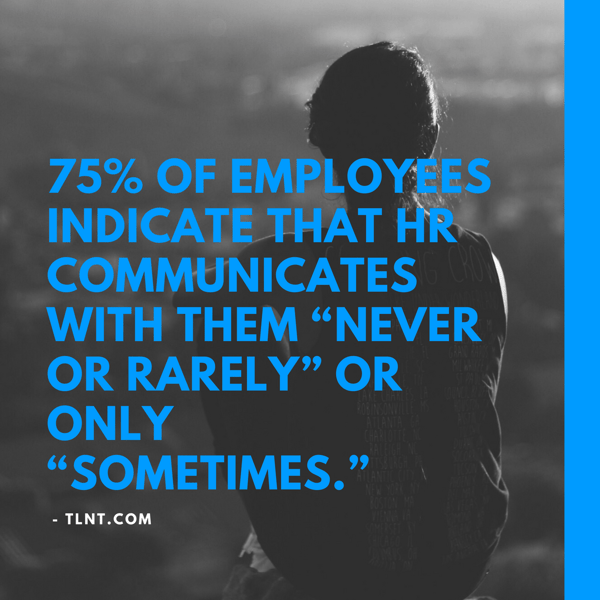
When was the last time you connected with your employees?
Have you been regularly mingling with all of your employees or have you been holed up in your office? Do you make yourself accessible and on a consistent basis communicate with employees? Or do you only communicate with people when you have to?
According to TLNT, 75% of employees indicated that HR communicates with them “Never or Rarely” or only “Sometimes.”
Talk about an alarm going off in everyone’s head. HR stands for Human Resources. If you’re not communicating with employees, that’s a large part of your job description that you’re neglecting.
As an additional terrifying thought, how many underlying problems have you been missing if you haven’t been talking with your employees?
2. Do your employees understand the company culture?

Not only employees, but fewer than 12% of companies believe they truly understand their culture. If no one understands what the culture is, then that means your communication is disjointed, you’re sending mixed messages to employees, your branding and messaging inside and outside the company is misaligned, and you’re likely having issues hiring and retaining talent.
As we mentioned in a previous blog, people care about the environment that they will be working in. They are spending on average 8 hours a day at your organization. Plus, if you want to retain employees, and not lose the best ones, you need to be investing in company culture. According to Achievers, 76% of employees in North America listed having a positive company culture as a main factor for staying with a company.
Ask around, can anyone clearly define your company culture, mission, and goals? If not, you’re likely in that 88%. And that’s not a good group to be in.
3. Managers are distant.

We’ve all had a variety of managers with different personalities and leadership styles. However, when you think about the worst types of manager, likely the worst 3 are:
- Abusive
- The Micro-Manager
- The Hands-Off
Now, the abusive managers need to go. We all know that they are the ones who have to be weeded out.
But the other two are a little more difficult. They aren’t deplorable and some employees need that type of manager. But when you take into account that, according to Achievers, bad managers are driving employees to leave, with 50% of people having left a job to get away from their boss; the warning sirens just keep getting louder in your head.
Also, according to TLNT.com, more than half of office professionals want more frequent check-ins with their supervisor.
So, what does that tell you? That communication is typically the root of the problem; whether it’s one of the “problem management styles” above or even a well-liked manager.
This is reflected in our main statistic here by hrdailyadvisor - "37% of respondents say they don’t feel close with their manager, and 70% would like to spend more time with their manager." The stat shows us that employees want open communication, which will drive further “closeness” and mutual respect.
So, when you look around your organization, do you see open communication? Or do you see distant or strained relationships? Do you see employees feeling lost and unsure?
If you see what more than half of employees see, then you see that more check-ins and communication is needed.
4. Employees don’t feel comfortable raising issues.

Speaking of communication, according to TLNT.com, nearly half of employees don’t feel comfortable raising issues or concerns with their manager between performance reviews and almost 75% say they would be more proactive in doing so if they received more frequent feedback.
HR has always feared this. If employees don’t feel comfortable raising issues, what are they going to do? Unfortunately, often these employees leave. You might be losing good employees because they don’t feel comfortable bringing up issues to their supervisors, which the stat even gives you a solution: give more frequent feedback.
By having open and respectful communication on a regular basis, employees would feel more comfortable with raising issues and would feel closer to their managers.
We all know that it won’t be the easiest, especially for a larger company, but it is a vital part of strengthening the company, management, company culture, and employee retention.
5. Leaders are not prepared to lead a diverse workforce.
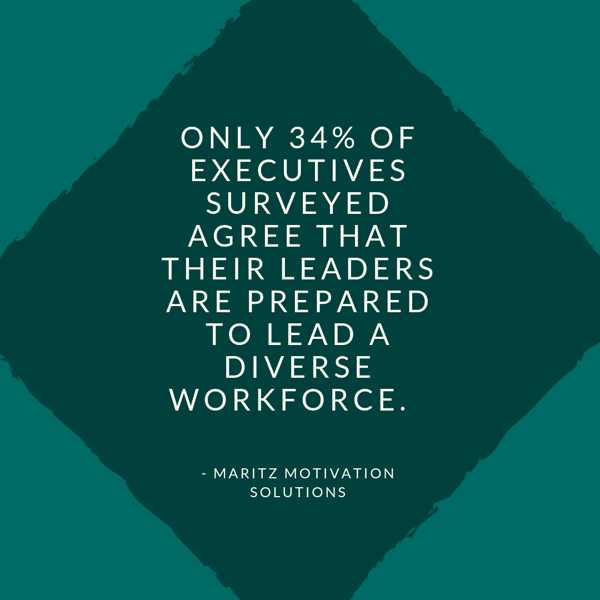
In this day and age, we want to diversify our workforce, bringing in new backgrounds, cultures, perspectives, and much more. Many find that the more diverse, the better.
However, according to Forbes, only 34% of executives surveyed agree that their leaders are prepared to lead a diverse workforce.
This tells you that executives do not have confidence in their managers to lead the diverse workforce that companies are working so hard for.
Can your company say the same? Do you feel that your various employees will respect, welcome, and be understanding towards everyone?
If you cannot say with the upmost confidence and maybe even think of a few examples where your workforce has been completely respectful and inclusive, then it sounds like there needs to be a lot of thought and training into this matter.
It’s a ticking time bomb when your leadership does not understand how to properly lead a diverse workforce and when it blows; it will be more than just an HR nightmare.
6. Managers can’t recognize employees even if they wanted to.
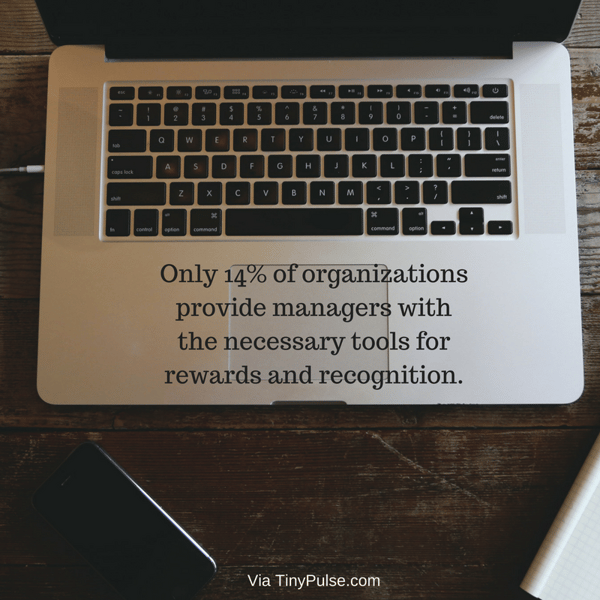
We all know the importance of employee recognition, if you don’t, then you need to be reading some of these articles ASAP and take a hard look at your processes and company culture.
- 3 Reasons Why Employee Recognition Will Always Matter
- A Great Employee Experience Makes For a Great Customer Experience
- Business Branding: The Importance and Impact of Company Branding
- The Power of Positive Employee Recognition
- The Importance of Employee Recognition
- Why Giving Recognition Is Necessary
- Trend Alert: Performance-Based Recognition
- Trophy Value
- 9 Ways to Celebrate a Corporate Anniversary
Those who understand the importance of employee recognition are not in the clear yet; according to TinyPulse, only 14% of organizations provide managers with the necessary tools for recognition.
So, even if you understand the importance, most organizations have not been supporting management with the necessary tools. How can your managers recognize your star employees and retain them if you can’t even recognize them for their accomplishments?
You won’t have your top employees for much longer if you can’t properly reward and recognize them. Don’t hemorrhage talent if it’s an easy fix like recognizing them for their accomplishments.
7. Most employees are disengaged.
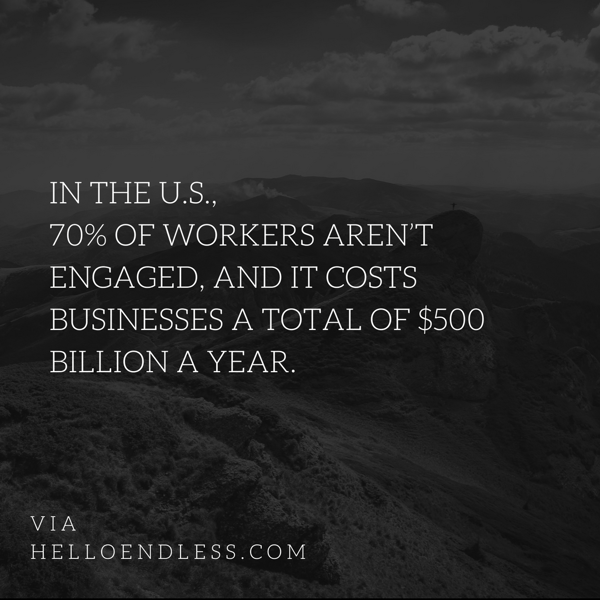
According to HelloEndless, in the U.S., 70% of workers aren’t engaged, and it costs businesses a total of $500 billion a year. That means a little less than 3/4th's of the working population is disengaged. That’s scary within itself because that means a good chunk of your employees are likely disengaged. Plus, if you start throwing in the amount of money disengaged workers cost businesses – not million, but billions per year. That’s quite an amount of people and money.
Do you know how disengaged your workforce is?
8. Many employees would not recommend their organization as a good place to work.
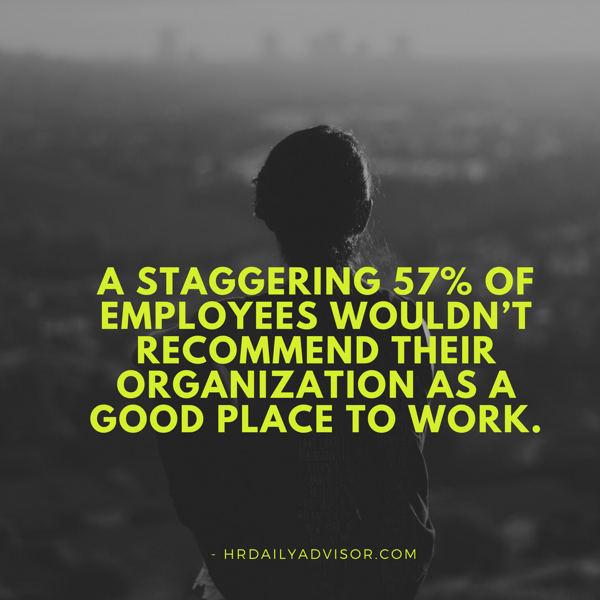
You want your employees to be brand ambassadors and create positive buzz about your company. The last thing any recruiter or HR professional wants is employees telling potential talent that your company is a bad place to work.
However, according to HRDailyAdvisor, a staggering 57% of employees wouldn’t recommend their organization as a good place to work.
Can you honestly say that your employees would give your organization a glowing review? Would they recommend your organization as a good place to work to their friends or family?
9. The majority of employees would consider leaving for the right offer.

We would all like to think that our employees are infallible. That our best employees and the ones who have been here are long time will never leave.
That’s a delusional way of thinking, according to Achievers because 81% of employees would consider leaving their current role for the right offer. That’s a significant number of people willing to jump ship at any time.
So, how are you going to ensure that your star players are in the 19% that wouldn’t leave?
10. Many employees are the only ones that have the skills, expertise, and knowledge to perform their job.
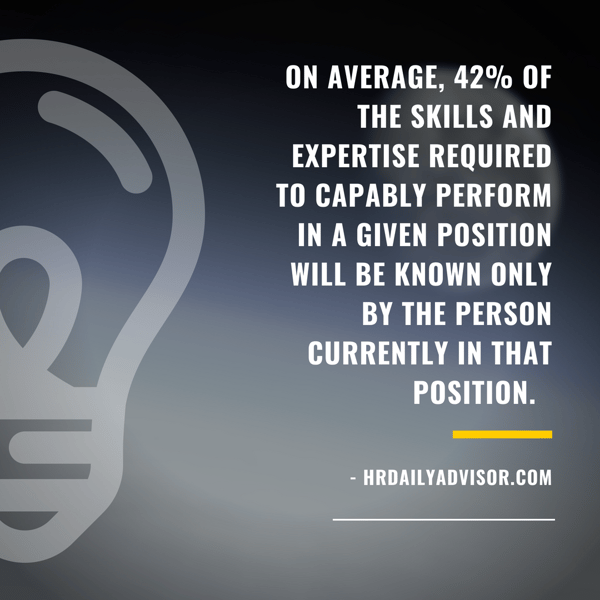
Look around your organization, if anyone left suddenly, would someone else be able to perform aptly or take over that position for a while? If the answer is no, then you are part of HRDailyAdvisor’s static that on average, 42% of skills and expertise required to capably perform in a given position will be known only by the person currently in that position. And that’s a problem.
Whether someone is in an accident and unable to return to work or if someone turns in their immediate notice, you never know when you will lose key employees. Since they are the only ones who have the knowledge, skills, and capabilities to do the position, your organization will have quite a gap. It might leave you scrambling to find someone to cover a vital position, searching for someone with enough info to handle an emergency, or even just find someone to fill the position but you will have severe difficulties training during onboarding. How do you even know what skills or needs to look for in a replacement?
If someone leaves who is the only person who knows how to do that position, a large skill and knowledge chasm is all that’s left.
10. Many employees are the only ones that have the skills, expertise, and knowledge to perform their job.

We all know that the candidate experience matters, but how many people actually take great care and actions to acknowledge this fact?
As you are checking out the applicants, the applicants are checking you out, too. According to TalentAdore.com, “78% of candidates say the overall candidate experience they get is an indicator of how a company values it people.”
If you want the right talent, then you have to make them feel valued and give them a clear understanding of the position, company, and other aspects. However, if you have a poor candidate experience, you’re not likely to get the prospects that you want.
This means from the application process on your website all the way to debriefing the new hire to what to bring on the first day. Even between the different management touchpoints.
So, do you have a candidate experience that you can be proud of that represents your company, culture, branding, people, and experience perfectly?
12. Candidates share their experience with others.
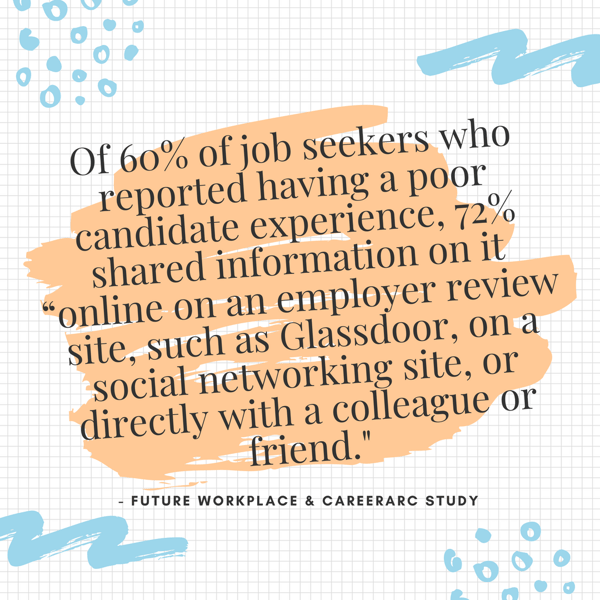
Knowing that from a recent study, of 60% of job seekers who have reported a poor candidate experience, 72% shared information on it “online on an employer review site, such as Glassdoor, on a social networking site, or directly with a colleague or friend.” Does it give you heart palpitations? If so, then you already know that if your candidate experience is poor, your previous candidates have likely already deterred other potential candidates from applying.
This is not even including the potential that your own employees have been telling people not to apply there, as according to the earlier stat.
For a business, having a small, and shrinking, talent pool is devastating.
So, whether you 100% know if your candidate experience is poor or not, it should be a high priority to address, especially if you need to fill some positions.
13. Candidates won’t work with companies with bad reputations.
.png?width=600&name=50%25%20of%20candidates%20say%20that%20they%20won%E2%80%99t%20work%20for%20a%20company%20with%20a%20bad%20reputation%20%E2%80%93%20even%20for%20a%20pay%20increase.%20(1).png)
I’ve mentioned the importance of branding before, and even 72% of recruiting leaders worldwide agree that employer brand has a significant impact on hiring. But the stat from socialseeder.com solidifies it by stating, “50% of candidates say that they won’t work for a company with a bad reputation – even for a pay increase.”
Some companies think that by throwing out more money they will be able to get the candidate they want, but that’s not a guarantee anymore. So, if you have all these candidates and employees saying that your company is not good to work for, you have an almost impossible hole to dig out of. It will significantly hurt your recruitment, and will hurt your bottom line as well. Word of Mouth can do wonders for a company’s marketing, but it can also destroy companies.
So, what is Word of Mouth doing for you – helping or hurting you?
You Are Part of These Statistics
I’m sure you noticed that many of these stats were interconnected. If you let any of these HR horror stories build, your organization will get into a downward spiral that will be impossible to retain and hire good talent from.
What’s the scariest of all, the majority of companies, based on those numbers, fall into at least one of these horrifying statistics.
Avoid these HR nightmares by learning how to actively engage your workforce. Create a positive company culture, develop an inspiring candidate experience, constitute open communication in your organization, train your management, and realign your company’s branding, mission, communication, and culture.
Get more tips from our blogs:
- Aligning Company Culture with Your Brand
- Personal & Professional Gift Ideas to Celebrate Accomplishments
- An In-Depth Guide to Onboarding and Developing New Salespeople
- Onboarding 101: A Guide to Starting an Onboarding Program
- Cause and Effect: The Positives and Negatives of Employee Recognition
- 17 Employee Recognition Facts You'll Love
- Why Giving Recognition is Necessary
- Business Branding: The Importance and Impact of Company Branding
![]() Kristina Hublar is your friendly neighborhood Marketing Specialist at Bruce Fox, Inc., which means she is the person behind the keyboard for the social media, emails, website, and other marketing efforts. She’s new(ish) to Bruce Fox, but is an Indiana native. In her spare time, you’ll find her bobbing along to music while crafting, spending time with loved ones, or with her nose in a book.
Kristina Hublar is your friendly neighborhood Marketing Specialist at Bruce Fox, Inc., which means she is the person behind the keyboard for the social media, emails, website, and other marketing efforts. She’s new(ish) to Bruce Fox, but is an Indiana native. In her spare time, you’ll find her bobbing along to music while crafting, spending time with loved ones, or with her nose in a book.







